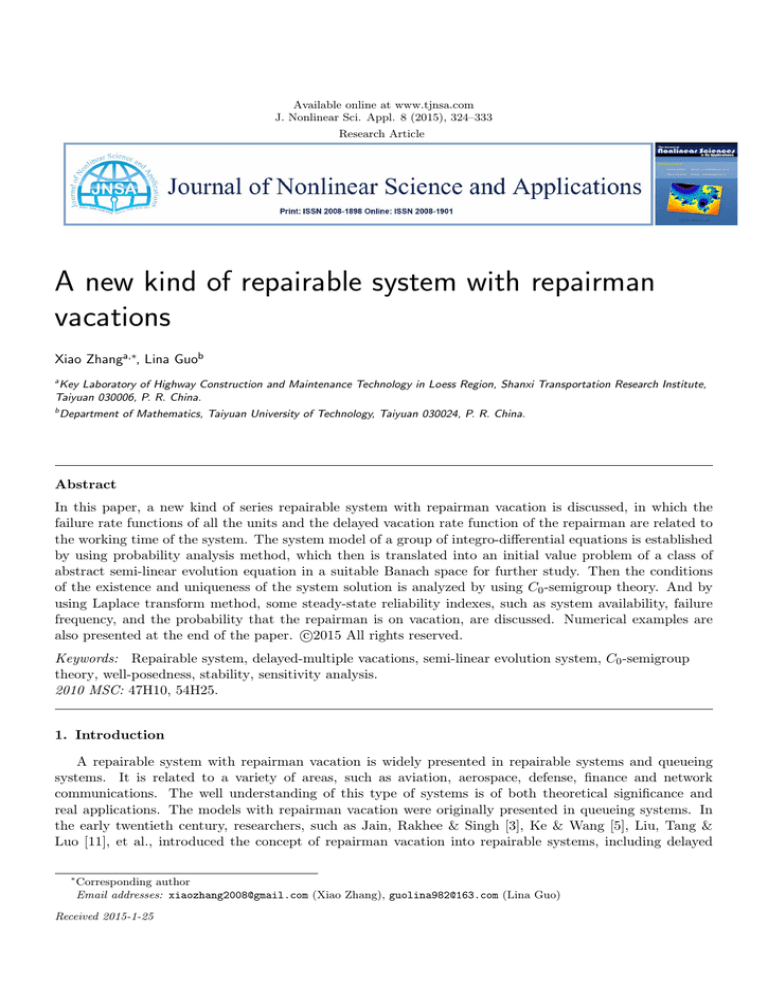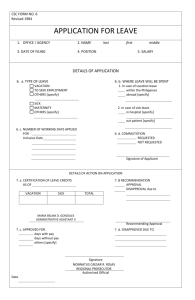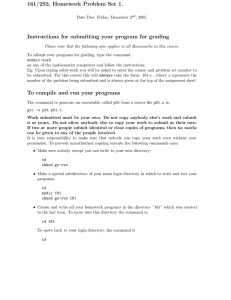
Available online at www.tjnsa.com
J. Nonlinear Sci. Appl. 8 (2015), 324–333
Research Article
A new kind of repairable system with repairman
vacations
Xiao Zhanga,∗, Lina Guob
a
Key Laboratory of Highway Construction and Maintenance Technology in Loess Region, Shanxi Transportation Research Institute,
Taiyuan 030006, P. R. China.
b
Department of Mathematics, Taiyuan University of Technology, Taiyuan 030024, P. R. China.
Abstract
In this paper, a new kind of series repairable system with repairman vacation is discussed, in which the
failure rate functions of all the units and the delayed vacation rate function of the repairman are related to
the working time of the system. The system model of a group of integro-differential equations is established
by using probability analysis method, which then is translated into an initial value problem of a class of
abstract semi-linear evolution equation in a suitable Banach space for further study. Then the conditions
of the existence and uniqueness of the system solution is analyzed by using C0 -semigroup theory. And by
using Laplace transform method, some steady-state reliability indexes, such as system availability, failure
frequency, and the probability that the repairman is on vacation, are discussed. Numerical examples are
c
also presented at the end of the paper. ⃝2015
All rights reserved.
Keywords: Repairable system, delayed-multiple vacations, semi-linear evolution system, C0 -semigroup
theory, well-posedness, stability, sensitivity analysis.
2010 MSC: 47H10, 54H25.
1. Introduction
A repairable system with repairman vacation is widely presented in repairable systems and queueing
systems. It is related to a variety of areas, such as aviation, aerospace, defense, finance and network
communications. The well understanding of this type of systems is of both theoretical significance and
real applications. The models with repairman vacation were originally presented in queueing systems. In
the early twentieth century, researchers, such as Jain, Rakhee & Singh [3], Ke & Wang [5], Liu, Tang &
Luo [11], et al., introduced the concept of repairman vacation into repairable systems, including delayed
∗
Corresponding author
Email addresses: xiaozhang2008@gmail.com (Xiao Zhang), guolina982@163.com (Lina Guo)
Received 2015-1-25
X. Zhang, L. N. Guo, J. Nonlinear Sci. Appl. 8 (2015), 324–333
325
vacation, single vacation and multiple vacations. To the authors’ best knowledge, most of available references
related to repairman vacation are interested in the system steady-state behaviors (for examples, please refer
to [4, 15, 14]). Guo, Xu, Gao & Zhu [2] discussed the well-posedness and stability of a series repairable
system with a repairman following delayed-multiple vacations policy, and analyzed the sensitivity analysis
of system parameters. However, the failure rates in all available references are either constants or at most,
are related to the age of a system (for example, please see [9, 10]), but not related to the working time of a
system. But in practice, the failure rates of a unit is generally dependent on the working time of the system.
For example, the failure rate can be increased with the system running. Then it will be decreased with the
measures such as preventive maintenance, periodic detection and periodic maintenance. For this reason, we
are dedicated to studying a repairable system with repairman vacation in which the failure rate of all the
units are related to the working time of the system.
The rest of present study is arranged as follows. In the following section, the system model is established
by using probability analysis method and then is translated into an initial value problem of a class of abstract
semi-linear evolution equation in a Banach space. In Section 3, some properties of the system operator are
discussed, thereby the existence and uniqueness, and the continuous dependence of the system solution for
the initial value are derived by using C0 -semigroup theory. In Section 4, we derive some reliability indexes,
such as steady-state availability, steady-state failure frequency, and steady-state probability of repairman
on vacation by using Laplace transform method. Section 5 does numerical analysis. And a brief conclusion
is presented in Section 6 at the end of the paper.
2. System formulation
The system model considered in this paper is an n-unit series repairable system with a repairman
following delayed-multiple vacations policy. The system is described specifically as follows: at the initial
time t = 0, all the units are new, the system begins to work and the repairman is preparing for the vacation.
If there is a unit failed in the delayed-vacation period, the repairman deals with it immediately and the
delayed vacation is terminated. Otherwise, he leaves for a vacation after the delayed-vacation period is
end. Whenever the repairman returns from a vacation, he either prepares for the next vacation if no units
are failed in the system or deals with the failed units immediately. The repair facility is neither failed nor
deteriorated during the whole process. The system is repaired as good as new.
Set all possible states of the system at time t as follows. 00: The system is working and the repairman
is preparing for the vacation. 01: The system is working and the repairman is on vacation. 1i: The unit i is
failed and the repairman is on vacation, and 2i: The repairman is dealing with the failed unit i, i = 1, 2, · · · , n.
Then with the probability analysis method, the system model can be described as below.
[
]
∫ ∞
n ∫ ∞
∑
d
+ ε(t) + Λ(t) P00 (t) =
r(x)P01 (t, x)dx +
µi (y)P2i (t, y)dy
dt
0
i=1 0
]
[
∂
∂
+
+ Λ(t) + r(x) P01 (t, x) = 0
∂t ∂x
[
]
∂
∂
+
+ r(x) P1i (t, x) = λi (t)P01 (t, x)
∂t ∂x
[
]
∂
∂
+
+ µi (y) P2i (t, y) = 0.
∂t ∂y
(2.1)
(2.2)
(2.3)
(2.4)
The boundary conditions are
P01 (t, 0) = ε(t)P00 (t)
P1i (t, 0) = 0
∫
P2i (t, 0) = λi (t)P00 (t) +
(2.5)
(2.6)
∞
r(x)P1i (t, x)dx,
0
(2.7)
X. Zhang, L. N. Guo, J. Nonlinear Sci. Appl. 8 (2015), 324–333
where i = 1, 2, · · · , n, Λ(t) =
n
∑
326
λi (t). The initial conditions are
i=1
P00 (0) = 1, the others equal to 0.
(2.8)
Here P00 (t) represents the probability that the system is in state 00 at time t; P01 (t, x) dx represents the
probability that the system is in state 01 with elapsed vacation time lying in [x, x+dx) at time t; P1i (t, x) dx
represents the probability that the system is in state 1i with elapsed vacation time lying in [x, x + dx) at
time t; P2i (t, y) dy represents the probability that the system is in state 2i with elapsed repair time lying
in [y, y + dy) at time t. ε(t) denotes the delayed vacation rate function, r(x) denotes the vacation rate
function, λi (t) denotes the failure rate function of unit i, µi (y) denotes the repair rate function of unit i,
i = 1, 2, · · · , n.
Concerning the practical background, we can assume that ε(t), λi (t), r(x), µi (y) are all nonnegative
bounded
functions
∫∞
∫ ∞ satisfying ε(t) → ε̂ ≥ 0, λi (t) → λ̂i ≥ 0 (t → ∞), r(x), µi (y) ∈ L[0, T ] (0 < T < ∞) and
0 r(x)dx = 0 µi (y)dy = ∞, i = 1, 2, · · · , n.
For further study, we will translate the system (2.1)-(2.8) into an initial value problem of a class of
abstract semi-linear evolution system in a Banach space.
Choose the state space X as below.
X = {P = (P00 , P01 , P11 , · · · , P1n , P21 , · · · , P2n )T |P00 ∈ R, Pj ∈ L1 (R+ ),
∑
∥Pj ∥ < ∞, j = 01, 1i, 2i, i = 1, 2, · · · , n},
∥P ∥ = |P00 | +
j
where R+ represents the set of nonnegative real numbers. Obviously, X is a Banach space.
Define operator A : D(A) ⊂ X → X as follows.
A(P00 , P01 (x), P11 (x), · · · , P1n (x), P21 (y), · · · , P2n (y))T
(∫
n ∫ ∞
∞
∑
′
=
r(x)P01 (x)dx +
µi (y)P2i (y)dy, −P01 (x) − r(x)P01 (x),
0
i=1
′
0
′
− P11 (x) − r(x)P11 (x), · · · , −P1n (x) − r(x)P1n (x),
′
′
−P21 (y) − µ1 (y)P21 (y), · · · , −P2n (y) − µn (y)P2n (y)
with
)T
,
P = (P00 , P01 , P11 , · · · , P1n , P21 , · · · , P2n )T ∈ X |
D(A) = Pj are differentiable in R+ and Pj′ ∈ L1 (R+ ),
j = 01, 1i, 2i, i = 1, 2, · · · , n.
Let f (t, P ) : [0, ∞) × X → X be
f (t, P ) = ( − (ε(t) + Λ(t))P00 (t), −Λ(t)P01 (t, x),
λ1 (t)P01 (t, x), · · · , λn (t)P01 (t, x), 0, · · · , 0)T .
Then the system (2.1)-(2.8) can be translated into an initial value problem of a class of abstract semilinear evolution system in Banach space X:
dP (t, ·)
= AP (t, ·) + f (t, P (t, ·)) t ≥ 0
dt
P (t, ·) = (P00 (t), P01 (t, x), P11 (t, x), · · · , P1n (t, x), P21 (t, y), · · · , P2n (t, y))T
P (0, ·) = P = (1, 0, 0, · · · , 0)T
0
1,2n+2 .
(2.9)
X. Zhang, L. N. Guo, J. Nonlinear Sci. Appl. 8 (2015), 324–333
327
3. Existence and uniqueness of system solution
The unique existence of the solution of the initial value problem of abstract semi-linear evolution equations, as so far, has been focused on by few researchers (such as Li [6, 7, 8] and Wang [13]). In this section, we
only discuss the unique existence of the mild solution of system (2.9) because of its limitation of the physical
condition, by using C0 -semigroup theory. Some properties of the system operator A will be presented first.
Lemma 3.1. The system operator A is densely defined in X.
Proof. For any F = (f00 , f01 , f11 , · · · , f1n , f21 , · · · , f2n )T ∈ X, then fj ∈ L1 (R+ ), j = 01, ∫1i, 2i,
∞
i = 1, · · · , n. Thus for any η > 0, there exist positive numbers Gj and δj such that G01 |f01 (x)|dx
∫
∫
∫
δ
∞
δ
η
η
η
< η9 , 0 01 |f01 (x)|dx < 18
and Gk |fk (ξ)|dξ < 9n
, 0 k |fk (ξ)|dξ < 18n
, k = 1i, 2i, i = 1, · · · , n. Let
{
δ = min δ01 , δ1i , δ2i ,
}
3η
∫∞
.
2{ηr + 9[(ε + Λ)|f00 | + 0 r(x)|f1i (x)|dx]}
Take P00 = f00 and
0≤x<δ
0≤x<δ
εP00 ,
0,
P01 (x) = g01 (x), δ ≤ x ≤ G01
P1i (x) = g1i (x), δ ≤ x ≤ G1i
0,
G01 < x < ∞
0,
G1i < x < ∞
∫∞
λi P00 + 0 r(x)P1i (x)dx, 0 ≤ y < δ
P2i (y) = g2i (y),
δ ≤ y ≤ G2i
0,
G2i < y < ∞.
Here, gj are continuously differentiable functions satisfying gj (Gj ) = 0, g01 (δ) = εP00 , g1i (δ) = 0, g2i (δ) =
∫G
∫∞
∫G
η
, j = 01, k; k = 1i, 2i; i =
λi P00 + 0 r(x)P1i (x)dx and δ 01 |f01 (x) − P01 (x)|dx < η9 , δ k |fk (ξ) − Pk (ξ)|dξ < 9n
′
1
1, 2, · · · , n. Then Pj are continuously differentiable functions and Pj ∈ L (R+ ). Thus P = (P00 , P01 , P11 , · · · ,
P1n , P21 , · · · , P2n )T ∈ D(A). Furthermore, it is not difficult to prove that ∥F − P ∥ < η. Therefore, D(A) is
dense in X.
Lemma 3.2. {ξ|ξ > ε + Λ} ⊂ ρ(A), where ρ(A) is the resolvent set of system operator A. And there exists
a constant W > 0, such that for any ξ > W ,
∥R(ξ; A)∥ ≤
1
ξ−W
where R(ξ; A) = (ξI − A)−1 .
Proof. For any F = (f00 , f01 , f11 , · · · , f1n , f21 , · · · , f2n )T ∈ X, consider the operator equation (ξI − A)P = F .
That is
∫
ξP00 −
∞
r(x)P01 (x)dx −
0
n ∫
∑
i=1
∞
µi (y)P2i (y)dy = f00
(3.1)
0
′
P01 (x) + [ξ + r(x)]P01 (x) = f01 (x)
′
P1i (x) + [ξ + r(x)]P1i (x) = f1i (x)
′
(3.2)
(3.3)
P2i (y) + [ξ + µi (y)]P2i (y) = f2i (y)
(3.4)
P01 (0) = εP00
P1i (0) = 0
(3.5)
(3.6)
∫
P2i (0) = λi P00 +
∞
r(x)P1i (x)dx
0
(3.7)
X. Zhang, L. N. Guo, J. Nonlinear Sci. Appl. 8 (2015), 324–333
328
where i = 1, 2, · · · , n. Solving equations (3.2)-(3.4) with the help of (3.5)-(3.7) derives
P01 (x) = εP00 e−
∫x
0
∫
[ξ+r(s)]ds
x
+
f01 (s)e−
∫x
s
[ξ+r(τ )]dτ
ds
0
∫x
= εP00 e− 0 [ξ+r(s)]ds + Y01 (x)
∫ x
∫x
∆
P1i (x) =
f1i (s)e− s [ξ+r(τ )]dτ ds = Y1i (x)
0
[
] ∫
∫ ∞
∫
− 0y [ξ+µi (s)]ds
+
P2i (y) = λi P00 +
r(x)P1i (x)dx e
∆
= λi P00 e−
∆
∫y
0
0
(3.8)
(3.9)
y
f2i (s)e−
∫y
s
[ξ+µi (τ )]dτ
ds
0
[ξ+µi (s)]ds
+ Y2i (y).
(3.10)
Substituting (3.8) and (3.10) into (3.1) yields
(ξ − εM −
∫
n
∑
λi Ni )P00
i=1
∞
=f00 +
r(x)Y01 (x)dx +
0
∫∞
n ∫
∑
i=1
∫∞
∫x
∞
µi (y)Y2i (y)dy,
0
∫y
µi (y)e− 0 [ξ+µi (s)]ds dy, i∫ = 1, 2, · · · , n. It is not hard to prove
where M = 0 r(x)e− 0 [ξ+r(s)]ds dx, Ni =
∫x 0
∫∞
∫∞
y
− t [ξ+r(s)]ds
that for any ξ > 0 and t ≥ 0, t r(x)e
dx
<
1,
µi (y)e− t [ξ+µi (s)]ds dy
t
∑n
< 1, i = 1, 2, · · · , n. Then ξ − εM − i=1 λi Ni > ξ − ε − Λ > 0, for any ξ > ε + Λ. Thus
f00 +
P00 =
∫∞
0
n ∫
∑
∞
r(x)Y01 (x)dx +
µi (y)Y2i (y)dy
0
i=1
∑n
.
ξ − εM − i=1 λi Ni
(3.11)
Moreover,
according to∫ [1], we can deduce that there exists a constant S > 0, such that ∀ t ≥ 0,
∫x
∫∞
y
r(τ )dτ
t
dx
≤ S, t e− t µi (τ )dτ dy ≤ S, i = 1, 2, · · · , n. Then from (3.8)-(3.11), it can be seen that for
t
any ξ > ε + Λ, the equations (3.1)-(3.7) have a unique solution P = (P00 , P01 , P11 , · · · , P1n , P21 , · · · , P2n )T ∈
D(A). This means that (ξI − A) is surjective. Because (ξI − A) is closed and D(A) is dense in X, then
(ξI − A)−1 exists and is bounded by Inverse Operator Theorem, for any ξ > ε + Λ.
Furthermore, the following estimations can be obtained with the equations (3.8)-(3.11).
∫∞
e−
∥F ∥
|P00 | <
ξ−ε−Λ
∫ ∞
ε|P00 | ∥f01 ∥
|P01 (x)|dx <
+
ξ
ξ
0
∫ ∞
∥f1i ∥
|P1i (x)| <
ξ
∫0 ∞
λi |P00 | ∥f1i ∥ ∥f2i ∥
|P2i (y)| <
+
+
.
ξ
ξ
ξ
0
(3.12)
(3.13)
(3.14)
(3.15)
Thus equations (3.12)-(3.15) follows the estimation:
∥P ∥ =|P00 | + ∥P01 ∥ +
n
∑
i=1
<
∥P1i ∥ +
n
∑
∥P2i ∥
i=1
3ξ − ε − Λ
1
∥F ∥ <
∥F ∥
ξ(ξ − ε − Λ)
ξ−W
where 0 < W < 8(ε + Λ)/9. This means that for any ξ > W , (ξI − A)−1 exits and ∥(ξI − A)−1 ∥ <
1
ξ−W .
X. Zhang, L. N. Guo, J. Nonlinear Sci. Appl. 8 (2015), 324–333
329
Lemma 3.3 ([12]). Let f : [t0 , T ] × X → X be continuous about t on [t0 , T ] and uniformly Lipschitz
continuous (with constant L) on X, if −A is the infinitesimal generator of a C0 semigroup T (t), t ≥ 0, on
X, then for every u0 ∈ X the initial value problem
{
du(t)
+ Au(t) = f (t, u(t)), t > t0
dt
u(t0 ) = u0
has a unique mild solution u ∈ C([t0 , T ] : X). Moreover, the mapping u0 → u is Lipschitz continuous from
X into C([t0 , T ] : X).
According to Hille-Yosida theorem [12] with Lemmas 3.1 and 3.2, the following result is obvious.
Theorem 3.4. The system operator A generates a C0 semigroup T (t).
Theorem 3.5. For any T > 0, assume ε(t) and λi (t) (i = 1, 2, · · · , n) are continuous on [0, T ]. Then
for any P ∈ X, if P01 (t, ·) ∈ C([0, T ] : L1 (R+ )), where P01 is the second component of P , the semi-linear
evolution system (2.9) has a unique mild solution P ∈ C([0, T ] : X). Moreover, the mapping P0 → P is
Lipschitz continuous from X into C([0, T ] : X).
Proof. For any T > 0, with the assumptions of the theorem, it is obvious that f (t, P ) is continuous about t
on [0, T ]. Furthermore, for any t ∈ [0, T ] and P, Q ∈ X, it is easy to know that
∥f (t, P ) − f (t, Q)∥ ≤ L∥P − Q∥
where{ P00 , P01 and Q00 , Q}01 are respectively the first and the second components of P and Q, and L =
2 max
sup ε(t), sup Λ(t) . Therefore, the result of theorem 3.5 is obvious by using Lemma 3.3.
t∈[0,T ]
t∈[0,T ]
4. Reliability indexes
In this section, we substitute the limit values ε̂ and λ̂i respectively for the delayed vacation rate ε(t)
of repairman and the failure rate λi (t) of each unit i, i = 1, 2, · · · , n in system (2.1)-(2.8), which can be
found in Section 2, and for simplicity, we will replace them with ε and λi in the following. Thus system is a
special case of [2] and then is stable. So in this section we can study steady-state reliability indexes of the
system with the method of Laplace transformation because the premise of Laplace transformation needs the
condition that the system solution is unique existed and stable.
Applying the Laplace transformation to equations (2.1)-(2.8), we can obtain the following equations.
(s + Λ +
∗
ε)P00
(s)
∫
∞
=1+
∗
r(x)P01
(s, x)dx
0
i=1
∗
dP01
(s, x)
∗
+ [s + Λ + r(x)]P01
(s, x) = 0
dx
∗
dP1i
(s, x)
∗
∗
+ [s + r(x)]P1i
(s, x) = λi P01
(s, x)
dx
∗
dP2i (s, y)
∗
+ [s + µi (y)]P2i
(s, y) = 0
dy
∗
∗
P01
(s, 0) = εP00
(s)
∗
P1i
(s, 0)
=0
∗
∗
P2i
(s, 0) = λi P00
(s) +
+
n ∫
∑
∞
∗
µi (y)P2i
(s, y)dy
(4.1)
0
(4.2)
(4.3)
(4.4)
(4.5)
(4.6)
∫
∞
0
∗
r(x)P1i
(s, x)dx
(4.7)
X. Zhang, L. N. Guo, J. Nonlinear Sci. Appl. 8 (2015), 324–333
330
where i = 1, 2, · · · , n. Solving equations (4.1)-(4.4) with the help of (4.5)-(4.7) follows
∗
P00
(s) = [
s 1 + εg(s) + (1 +
∗
P01
(s, x)
=
∗
εP00
(s)e−
∫x
0
1
ε
Λ ((s
+ Λ)f (s) − sg(s)))
]
λi hi (s)
n
∑
i=1
[s+Λ+r(τ )]dτ
∫x
ελi ∗
P00 (s)e− 0 [s+r(τ )]dτ (1 − e−Λx )
Λ
[
] ∫y
ε
∗
∗
P2i (s, y) = λi P00
(s) 1 + ((s + Λ)f (s) − sg(s)) e− 0 [s+µi (τ )]dτ
Λ
∗
P1i
(s, x) =
where
∫
∞
f (s) =
e−
∫x
0
∫
(s+Λ+r(τ ))dτ
∫
0
∞
hi (s) =
∞
dx, g(s) =
e−
∫x
0
(s+r(τ ))dτ
dx
0
e−
∫y
0
(s+µi (τ ))dτ
dy, i = 1, 2, · · · , n.
0
For the preparation, some steady state indexes of the system (2.1)-(2.8) can be derived as follows.
Theorem 4.1. The stead-state availability of the system is
1 + εf
Av =
1 + εg + (1 + εf )
n
∑
λi hi
i=1
where f =
∫∞
0
e−
∫x
0
[Λ+r(τ )]dτ
dx, g =
∫∞
0
e−
∫x
0
r(τ )dτ
dx, hi =
∫∞
0
e−
∫y
0
dy, i = 1, 2, · · · , n.
µi (τ )dτ
∫∞
Proof. The instantaneous availability of the system at time t is Av (t) = P00 (t) + 0 P01 (t, x)dx. According
to Taubert theorem, the stead-state availability of the system can be obtained readily. That is
sA∗v (s)
Av = lim Av (t) = lim
t→∞
s→0
[
∫
∗
= lim s P00 (s) +
s→0
1 + εf
=
1 + εg + (1 + εf )
n
∑
∞
]
∗
P01
(s, x)dx
0
.
λi hi
i=1
Theorem 4.2. The stead-state probability of the repairman on vacation is
εg
Pv =
1 + εg + (1 + εf )
n
∑
.
λi hi
i=1
Proof. The probability that the repairman is on vacation at time t is Pv (t) =
∫∞
0
P01 (t, x)dx+
n ∫
∑
∞
i=1
0
P1i (t, x)dx.
Then the stead-state probability of the repairman on vacation can be yielded by using the limit theorem as
below.
Pv = lim Pv (t) = lim sPv∗ (s)
t→∞
s→0
[∫ ∞
n ∫
∑
∗
= lim s
P01 (s, x)dx +
s→0
=
0
i=1
εg
1 + εg + (1 + εf )
n
∑
λi hi
i=1
where g and hi (i = 1, 2, · · · , n) is defined in Theorem 4.1.
∞
0
]
∗
P1i
(s, x)dx
X. Zhang, L. N. Guo, J. Nonlinear Sci. Appl. 8 (2015), 324–333
331
Theorem 4.3. The stead-state failure frequency of the system is
Wf = ΛAv
[
Proof. According to Ref. [1] the instantaneous failure frequency of the system at time t is Wf (t) = Λ P00 (t)+
∫∞
]
P01 (t, x)dx .
Applying the limit theorem and noting the result of Theorem 4.1, the result of Theorem
4.3 can be yielded readily.
0
5. Numerical analysis
In this section, we present some examples to illustrate the results obtained above. For simplicity, we
consider the simple system (i.e.one-unit system) corresponding to system (2.1)-(2.8), in which the repair
time of the unit and the vacation time of the repairman both follow exponential distributions. That is,
r(x) ≡ r, µ(y) ≡ µ, where r and µ are nonnegative constants.
Furthermore, we assume ε(t) = 0.1, for t ∈ [0, 1); 0.5, for t ∈ [1, 3); 1, for t ∈ [3, ∞) and λ(t) = 1
for t ∈ [0, 1); 0.5, for t ∈ [1, 3); 0.01, for t ∈ [3, ∞). Figures 1-4 present the instantaneous availabilities,
instantaneous probabilities of the repairman on vacation, instantaneous probabilities of the system in failure
state and instantaneous probabilities of the system in good state with different repair rate µ and vacation
rate r.
Figure 1: Transient availabilities with different repair and vacation rates
Figure 2: Transient vacation probabilities with different repair and vacation rates
X. Zhang, L. N. Guo, J. Nonlinear Sci. Appl. 8 (2015), 324–333
332
Figure 3: Transient failure probabilities with different repair and vacation rates
Figure 4: Transient good-state probabilities with different repair and vacation rates
From the figures, we can deduce the following conclusions.
(i) The instantaneous availability of the simple system first decreases then increases with the increasing
of delay-vacation rate ε and decreasing of failure rate λ, and increases with the increasing of vacation rate
r and repair rate µ.
(ii) The instantaneous probability of the repairman on vacation increases with the increasing of delayvacation rate ε and decreasing of failure rate λ, and decreases with the increasing of vacation rate r and
repair rate µ in steady state.
(iii) The instantaneous probability of the system in failure state first increases then decreases with the
increasing of delay-vacation rate ε and decreasing of failure rate λ, and decreases with the increasing of
vacation rate r and repair rate µ.
(iv) The instantaneous probability of system in good state (i.e. the probability of the repairman in
delayed vacation stage) decreases with the increasing of delay-vacation rate ε and decreasing of failure rate
λ, and increases with the increasing of vacation rate r and repair rate µ in steady state.
Acknowledgements
This work is supported by the TianYuan Special Funds of the National Natural Science Foundation of
China under Grant 11226249, the Foundation Research Project of Shanxi Province (The Youth) under Grant
2012021015-5, and by the Youth Foundation of Taiyuan University of Technology under Grant 2012L031.
X. Zhang, L. N. Guo, J. Nonlinear Sci. Appl. 8 (2015), 324–333
333
References
[1] J. H. Cao, K. Cheng, Introduction to reliability mathematics, Higher education press, Beijing, (1986). 3, 4
[2] L. N. Guo, H. B. Xu, C. Gao, G. T. Zhu, Stability analysis of a new kind n-unit series repairable system, Appl.
Math. Model., 35 (2011), 202–217. 1, 4
[3] M. Jain, Rakhee, M. Singh, Bilevel control of degraded machining system with warm standbys, setup and vacation,
Appl. Math. Model., 28 (2004), 1015–1026. 1
[4] J. S. Jia, S. M. Wu, A replacement policy for a repairable system with its repairman having multiple vacations,
Comput. Ind. Eng., 57 (2009), 156–160. 1
[5] J. C. Ke, K. H. Wang, Vacation policies for machine repair problem with two type spares, Appl. Math. Model.,
31 (2007), 880–894. 1
[6] Y. X. Li, The positive solutions of abstract semilinear evolution equations and their applications, Acta Math.
Sinica, 39 (1996), 666–672. 3
[7] Y. X. Li, Existence and uniqueness of positive periodic solutions for abstract semilinear evolution equations, J.
Syst. Sci. Math. Sci., 28 (2005), 720–728. 3
[8] Y. X. Li, Existence of Solutions of Initial Value Problems for Abstract Semilinear Evolution Equations, Acta
Math. Sinica, 48 (2005), 1089-1094. 3
[9] R. B. Liu, Y. H. Tang, One-unit repairable system with multiple delay vacations, Chinese J. Eng. Math., 23
(2006), 721–724. 1
[10] R. B. Liu, Y. H. Tang, Reliability analysis of a two-dissimilar-unit cold standby system with separated repair rule,
J. Syst. Eng., 21 (2006), 628–635. 1
[11] R. B. Liu, Y. H. Tang, C. Y. Luo, A new kind of N-unit series repairable system and its reliability analysis, Math.
Appl., 20 (2007), 164–170. 1
[12] A. Pazy, Semigroups of linear operators and applicaton to partial differential equations, Springer-Verlag, New
York, (1983). 3.3, 3
[13] L. L. Wang, Studies of some aspects on abstract semilinear evolution solutions and functional differential equations, College of Mathematics and Econometrics, Hunan University, (2001). 3
[14] Q. T. Wu, S. M. Wu, Reliability analysis of two-unit cold standby repairable systems under Poisson shocks, Appl.
Math. Comput., 218 (2011), 171–182. 1
[15] L. Yuan, J. Xu, A deteriorating system with its repairman having multiple vacations, Appl. Math. Comput., 217
(2011), 4980–4989. 1




